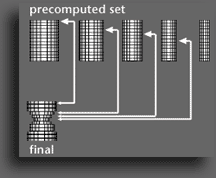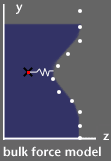a holographic video image of the same geometry. An interacting

|
wendy
plesniak &
|
|||||||||||
|
ravikanth
pappu
|
|||||||||||
 |
|||||||||||
 |
|||||||||||
| Lathe has three subsystems: the haptics |  |
||||||||||
| module, the holovideo module, and the | |||||||||||
| model manager. The haptics module runs | |||||||||||
| our force simulation and drives the force- | |||||||||||
| feedback device. The holovideo module | |||||||||||
| precomputes holograms, and drives rapid | |||||||||||
| local updates on the holovideo display. | |||||||||||
| The model manager keeps the visual and | |||||||||||
| haptic representations in sync. | |||||||||||
| The force simulation runs at an average | |||||||||||
| servo rate of 5kHz, and the holovideo | |||||||||||
| update rate is 10fps. The system operates | |||||||||||
| with 1s of lag between haptic and hologram | |||||||||||
| updates. Thus, typically, as a person lathes, | |||||||||||
| the surface is immediately felt to change | |||||||||||
| and seen to change a second later. | |||||||||||
 |
|||||||||||
| Lathe achieves near-real-time holovideo updates by | |||||||||||
| using a set of precomputed holograms of cylindrical | |||||||||||
| stocks having different radii. The final image is | |||||||||||
| then assembled from appropriate regions of this | |||||||||||
| precomputed hologram set, and only changed in | |||||||||||
| regions where the model has been affected by a | |||||||||||
| person's carving. By making line-level changes, we | |||||||||||
| avoid recomputing the entire 36MB holographic | |||||||||||
| fringe pattern at each update. | |||||||||||
| Using such specific precomputed elements permits | |||||||||||
| only a limited set of images to be assembled. Our | |||||||||||
| third holo-haptic experiment, Poke, addresses | |||||||||||
| this problem by using more generalized precomputed | |||||||||||
| fringes to assemble a more arbitrary final image. | |||||||||||
 |
|||||||||||
| The force model is given by a 1D | |||||||||||
| NURB curve which sweeps out | |||||||||||
| a surface of revolution. Pressing | |||||||||||
| into the model with the Phantom | |||||||||||
| stylus causes a force to be displayed | |||||||||||
| back to the hand; pressing with | |||||||||||
| enough force causes model control | |||||||||||
| points to be displaced inward and | |||||||||||
| the stock deforms uniformly | |||||||||||
| around its circumference. | |||||||||||
|
Finally,
the completed model data
|
 |
||||||||||
|
can
be dispatched to a 3D printer to
|
|||||||||||
|
produce
a physical hardcopy of the
|
|||||||||||
|
carved
design. The model shown to
|
|||||||||||
|
the
right was printed on a Stratasys
|
|||||||||||
|
3D
printer. The entire process serves
|
|||||||||||
|
as
one example of a future design
|
|||||||||||
|
and
prototyping pipeline.
|
|||||||||||
| Selected references : | |||||||||||
| Ravikanth Pappu and Wendy Plesniak, "Haptic interaction with holographic video images", Proceedings | |||||||||||
| of the IS&T/SPIE's Symposium on Electronic Imaging, Practical Holography XII, January 1998. | |||||||||||
|
Wendy
Plesniak and Ravikanth Pappu, "Coincident
display using haptics and holographic video",
|
|||||||||||
|
Proceedings
of ACM SGICHI Conference on Human Factors in Computing Systems,
April 1998.
|
|||||||||||
|
Wendy
Plesniak and Ravikanth Pappu, "Spatial
interaction with haptic holograms", Proceedings
of
|
|||||||||||
|
the
IEEE International Conference on Multimedia Computing and Systems
(ICMCS'99), June 1999.
|
|||||||||||
|
Wendy
Plesniak and Ravikanth Pappu, "Tangible,
dynamic holographic images", in Kuo, C.J. (Ed.),
|
|||||||||||
|
3-D
Holographic Imaging. Wiley-Interscience (invited, in press).
|
|||||||||||
| Sponsors of this work include Honda R&D Company, | |||||||||||
| NEC, IBM, the Digital Life Consortium at the MIT | |||||||||||
| Media Laboratory, the Office of Naval Research | |||||||||||
| (Grant N0014-96-11200), Interval Research Corporation, | |||||||||||
| and Mitsubishi Electric Research Laboratories. | |||||||||||